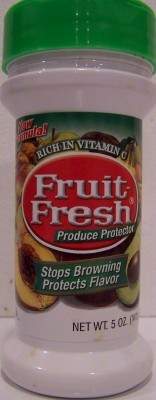
Looking for How to can your own homemade pickled peaches (complete directions with photos) in 2025? Scroll down this page and follow the links. And if you bring home some fruit or vegetables and want to can, freeze, make jam, salsa or pickles, see this page for simple, reliable, illustrated canning, freezing or preserving directions. There are plenty of other related resources, click on the resources dropdown above. If you are having a hard time finding canning lids, I've used these, and they're a great price & ship in 2 days.
If you have questions or feedback, please let me know! There are affiliate links on this page. Read our disclosure policy to learn more.
How to can your own homemade pickled peaches (complete directions with photos)
How to Make Homemade Canned Peach Pickles (Pickled Peaches), Plums, Pears, Plums and Nectarines
Click here for a PDF print version
You think pickling and canning your own pickled peaches, pickled pears, pickled plums or pickled nectarines is difficult or expensive? Not at all! Here's how to do it, complete instructions in easy steps and completely illustrated. In the winter when you open a jar, the peaches will taste MUCH better than anything you've ever had from a store, and by selecting the right fruit, it will use less sugar than store-bought canned peach pickles (Pickled Peaches). Peaches, pears, plums, cherries or nectarines can be packed in very light, light or medium sugar syrup. They can also be packed in water, apple juice or white grape juice.
Prepared this way, the jars have a shelf life of about 12 to 18 months, and
aside from storing in a cool, dark place, require no special attention.
If you'd rather freeze your fruit, see
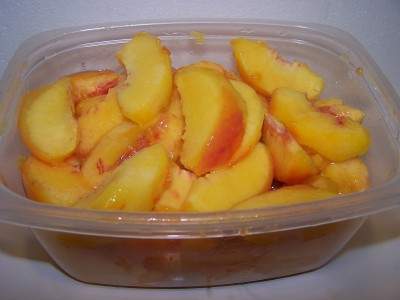 my
page on
how to freeze peaches, plums,
nectarines, figs and cherries. Even easier than canning and they will taste
just like fresh.. but it does take up space in the freezer.
my
page on
how to freeze peaches, plums,
nectarines, figs and cherries. Even easier than canning and they will taste
just like fresh.. but it does take up space in the freezer.
And here are some great and easy peach desert recipes!
Directions for Making Canned Peach Pickles (Pickled Peaches), Pears, Plums, Cherries or Nectarines
Yields about six pint jars.
Ingredients and Equipment
|
|
Recipe and Directions
Step 1 - Selecting the peaches, plums, cherries or nectarines
 The
most important step! You need 8 pounds of peeled, pitted peaches
peaches that are sweet, and to make the work easier, cling-free (also
called freestone). This means that the peach separates easily from
the pit! Same with nectarines, and this doesn't apply to cherries or
plums. Don't miss the peach
picking tips page!
The
most important step! You need 8 pounds of peeled, pitted peaches
peaches that are sweet, and to make the work easier, cling-free (also
called freestone). This means that the peach separates easily from
the pit! Same with nectarines, and this doesn't apply to cherries or
plums. Don't miss the peach
picking tips page!
Choose ripe, mature fruit of ideal quality for eating fresh or cooking. They should not be mushy, but they also should not be rock hard: just as ripe as you would eat them fresh.
After this step, I'll just refer to "peaches" but it applies to plums, pears, cherries and nectarines.
Step 2 - How many peaches and where to get them
You can pick your own, or buy them at the grocery store. But for large quantities, you will find that real* farmer's markets, like the Farmer's Market in Forest Park, Georgia have them at the best prices.
It takes about 5 good sizes peaches or nectarines (or about 10 plums) to fill one quart jar. This recipe calls for about 10 lbs of fruit to produce 6 or 7 pint jars., about 11/2 to 2 pounds of fresh, raw fruit per finished pint.
* - not the cutesy, fake farmer's markets that are just warehouse grocery stores that call themselves farmer's markets.
Step 3 - Wash the jars and lids
 This
is a good time to get the jars ready! The dishwasher is fine for the jars;
especially if it has a "sanitize" cycle. Otherwise put the jars in boiling
water for 10 minutes. I just put the lids in a small pot of almost boiling
water for 5 minutes, and use the magnetic "lid lifter wand" (available
from target, other big box stores, and often grocery stores; and available
online - see this page) to pull them out.
This
is a good time to get the jars ready! The dishwasher is fine for the jars;
especially if it has a "sanitize" cycle. Otherwise put the jars in boiling
water for 10 minutes. I just put the lids in a small pot of almost boiling
water for 5 minutes, and use the magnetic "lid lifter wand" (available
from target, other big box stores, and often grocery stores; and available
online - see this page) to pull them out.
Step 4 -Wash the peaches!
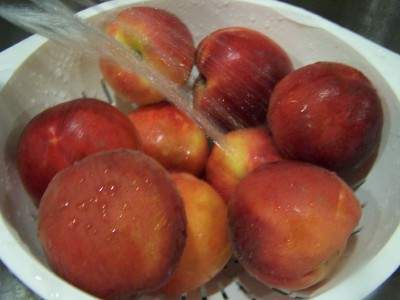 I'm
sure you can figure out how to wash the peaches in plain cold or lukewarm
water
I'm
sure you can figure out how to wash the peaches in plain cold or lukewarm
water
Step 5 - Peeling the Peaches
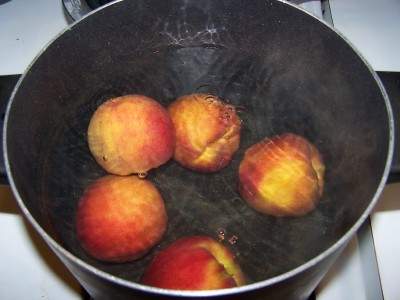
Nope, we're not going to peel them by hand; that's way too much work. Instead, here's a great trick that works with many fruits and vegetables with skins (like tomatoes): just dip the fruit in boiling water for 20 to 45 seconds.
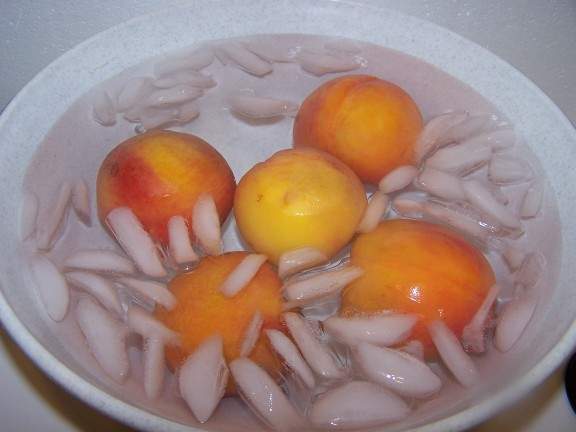 Remove
from the boiling water using a slotted spoon and put into a large bowl or
pot of cold water and ice for several minutes
Remove
from the boiling water using a slotted spoon and put into a large bowl or
pot of cold water and ice for several minutes
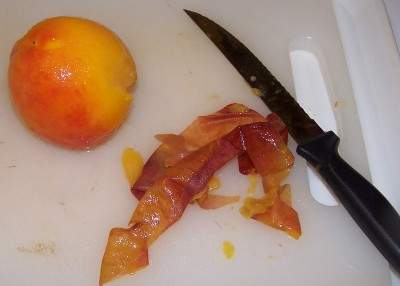 The
skins will easily slide off now!
The
skins will easily slide off now!
Nectarines do not need to be peeled, if you don't mind the skins. Neither do peaches, but most people prefer them with skins off - they tend to be slimy after all this.
Step 6 - Cut up the peaches
 Cut
out any brown spots and mushy areas. Cut the peaches in half, or quarters
or slices, as you prefer! Remove pits!
Cut
out any brown spots and mushy areas. Cut the peaches in half, or quarters
or slices, as you prefer! Remove pits!
Step 7 - Prevent the fruit from darkening!
Peaches will turn brown when exposed to air, even air in a sealed,
sterile jar. To keep the fruit from turning brown, when you get a
bowlful, sprinkle 1/4 cup lemon juice or Fruit-Fresh (which is just a
mix of citric acid and vitamin C, perfectly natural). Then stir
the peaches to make sure all the surfaces have been coated.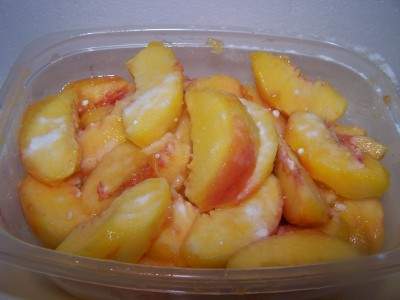
Step 8 - Prepare the sugar (or other sweetener) solution
Peaches must be packed in a solution of water and sugar or fruit juice. It's up to you which to use. Sugar is added to improve flavor, help stabilize color, and retain the shape of the fruit. It is not added as a preservative. Sugar solution is much less expensive (unless you have a supply of cheap grape juice), so I usually use a light solution to keep sugar (and the added calories) to a minimum.
To prepare syrup, mix the following in a pot:
- 63/4 cups sugar or Stevia (in a prepared form like Truvia, it measures same as sugar; if you use another form, you will need do your own conversion) - or Splenda, if you prefer, (or 4 cups of honey)
- 1 quart vinegar
Stir and bring to a gentle boil and keep it simmering for 5 minutes. Skim off any foam.
Step 9 - Put the spices in cheesecloth and add them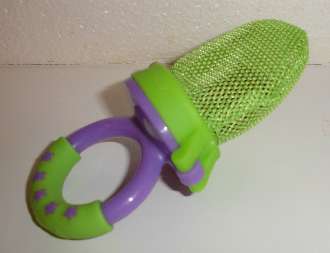
Put the
- 2 tablespoons whole cloves, crushed
- 1 tablespoon ground ginger
- 4 sticks cinnamon (2 inches long)
Tie the cinnamon sticks and whole cloves in a double thickness of cheesecloth and add them to the pot. For spicier peaches, use additional cloves and cinnamon sticks. I use a baby's ice lollipop bag (available at mall kitchen stores, Target and other local "big box" stores) as it is reusable and easy to use (see the photo).
Step 10 - Cook the peaches
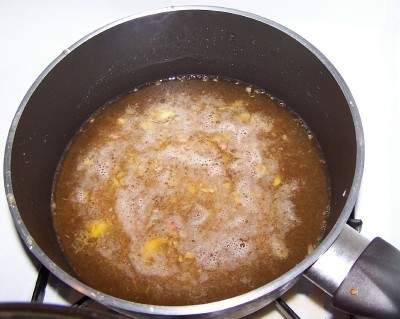 If
the peaches are sitting in water, drain them, then gently drop the
drained peaches into the boiling syrup and cook until they can be
pierced with a fork, but are not yet soft. This heat treatment infuses
the peaches with the spice and sweetener.
If
the peaches are sitting in water, drain them, then gently drop the
drained peaches into the boiling syrup and cook until they can be
pierced with a fork, but are not yet soft. This heat treatment infuses
the peaches with the spice and sweetener.
It also helps top reduce air entrapment (bubbles) as the cell structure of peaches tends to retain air; which is released during the heating prior to the jars being filled. Hot packing also tends to produce brighter colors.
Step 11 - Allow the peaches to rest in syrup overnight
Remove from range and allow peaches to set in syrup overnight to plump. The "plumping" or swelling needs to occur before sealing in jars.
I leave them on the counter until they've cooled to room temperature, then place them in the fridge.
Step 12 - The next day, reheat the peaches
Bring the peaches in syrup back to a boil.pack into hot jars, leaving headspace.
Step 13 - Fill the jars
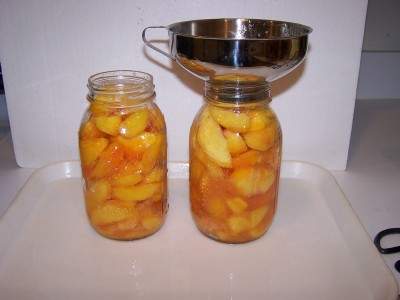 Pack
the peaches into sanitized jars (leaving 1/2-inch space at the top) and
cover with boiling sugar syrup leaving the 1/2-inch headspace. Run a rubber
spatula or table knife gently between peaches and jar to release trapped
air bubbles. To do this more effectively, tilt the jar slightly while
running the tool between the fruit and the edge of the jar and also
pressing inward against the fruit a few times.
Pack
the peaches into sanitized jars (leaving 1/2-inch space at the top) and
cover with boiling sugar syrup leaving the 1/2-inch headspace. Run a rubber
spatula or table knife gently between peaches and jar to release trapped
air bubbles. To do this more effectively, tilt the jar slightly while
running the tool between the fruit and the edge of the jar and also
pressing inward against the fruit a few times.
After packing the peaches in the jar, pour the sugar solution up to 1/2 inch (1 cm) from the top. the fruit should be covered completely. If you have problems with fruit darkening (turning brown) later, then sprinkle 1/2 teaspoon of FruitFresh or ascorbic acid into the top of the jar before you seal it. See here for related tools, equipment, supplies on Amazon
Wipe rim and screw threads with a clean damp cloth. Add lid, screw band and tighten firmly and evenly. Do not over tighten.
Tips!
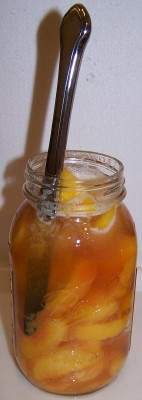 Canned
fruits often will float if the sugar syrup is too heavy, if jars are
packed too loosely or if air remains in the tissues of the fruit after
processing. To avoid this use a light or medium sugar syrup, make sure
fruit is firm and ripe and pack fruit tightly in jars without crushing.
Canned
fruits often will float if the sugar syrup is too heavy, if jars are
packed too loosely or if air remains in the tissues of the fruit after
processing. To avoid this use a light or medium sugar syrup, make sure
fruit is firm and ripe and pack fruit tightly in jars without crushing.
If fruit is not covered by liquid it may darken during storage (but does
not necessarily mean it is spoiled, as all fruits will darken somewhat).
To avoid this be sure fruit is covered by removing air bubbles from jars
liquid while still leaving the recommended head space. Also be sure to
remove trapped air bubbles as described earlier.
Peaches, pears and apples may also show a blue, red or pink color change
after canning. This is the result of natural chemical changes that
sometimes occur as fruits are heated. It is harmless and won't affect
flavor!
Also, avoid storing canned food near heat sources such as a furnace,
water heater, hot water or sunny areas. Jars need to be kept cool and
dark for longer storage life and to protect against spoilage. Be sure to
store in a dry place. If the lid or band rusts, that can cause the seal
to break.
Step 14 - Process the jars in the water bath
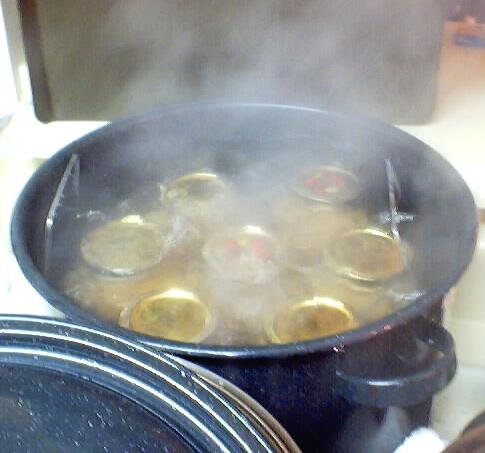 Put
the sealed jars in the canner and keep them cover with at least 1 inch
of water and boiling. In general, if you are at sea level, boil them for
20 minutes.
Put
the sealed jars in the canner and keep them cover with at least 1 inch
of water and boiling. In general, if you are at sea level, boil them for
20 minutes.
Here are more specific guidelines from the USDA for canning peaches in a boiling-water, a dial, or a weighted-gauge canner:
|
Table 1.
Recommended process time for
Peaches, halved or sliced |
||||||
| - |
Process Time at Altitudes of
|
|||||
| Style of Pack | Jar Size | 0 - 1,000 ft | 1,001 - 3,000 ft | 3,001 - 6,000 ft | Above 6,000 ft | |
| Hot |
Pints Quarts |
20 min 25 |
25 30 |
30 35 |
35 40 |
|
| Raw |
Pints Quarts |
25 30 |
30 35 |
35 40 |
40 45 |
|
|
Table 2. Process Times for
Peaches (Halved or Sliced)
|
||||||
| Canner Pressure (PSI) at Altitudes of | ||||||
| Style of Pack | Jar Size | Process Time (Min) | 0 - 2,000 ft | 2,001 - 4,000 ft | 4,001 - 6,000 ft | 6,001 - 8,000 ft |
| Hot and Raw |
Pints or Quarts |
10 | 6 | 7 | 8 | 9 |
|
Table 3. Process Times for
Peaches (Halved or Sliced)
|
||||
| Canner Pressure (PSI) at Altitudes of | ||||
| Style of Pack | Jar Size | Process Time (Min) | 0 - 1,000 ft | Above 1,000 ft |
| Hot and Raw |
Pints or Quarts |
10 | 5 | 10 |
Step 15 - Remove and cool
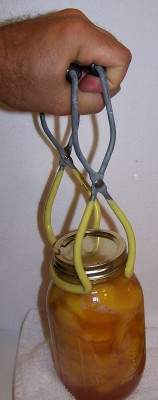 Lift
the jars out of the water and let them cool without touching or bumping
them in a draft-free place (usually takes overnight), here they won't be
bumped. You can the
Lift
the jars out of the water and let them cool without touching or bumping
them in a draft-free place (usually takes overnight), here they won't be
bumped. You can the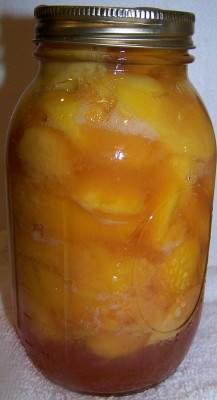 n
remove the rings if you like, but if you leave them on, at least loosen them quite a bit, so they don't rust in place due to trapped moisture.
n
remove the rings if you like, but if you leave them on, at least loosen them quite a bit, so they don't rust in place due to trapped moisture.
Once the jars are cool, you can check that they are sealed verifying that the lid has been sucked down. Just press in the center, gently, with your finger.
If it pops up and down (often making a popping sound), it is not sealed. If you put the jar in the refrigerator right away, you can still use it. Some people replace the lid (with a new lid) and reprocess the jar, while it's still hot for the full time in the canner - that's acceptable!
This recipe was originally from Clemson University!
Other Equipment:
From left to right:
- Jar lifting tongs
helpful to pick up hot jars
- Lid lifter
- to remove lids from the pot
of hot water - Lids
- disposable - you may only
use them once - Ring
- holds the lids on the jar until after
the jars cool - then you remove them, save them and reuse them - Canning Jar funnel
- to fill the jars
Frequently asked questions!
- Is it safe to can unpeeled peaches? I've spent hours on websites and
read several books on canning - to no avail. This is the second year
I've canned unpeeled peaches in a 5 to 1 water to sugar syrup (we're
still alive). All my friends, their mothers and everything I've read
says to peel and I'm beginning to buckle under all the finger
wagging!!!
Answer: Buckle not! It is perfectly safe to can peaches with the skins on! Most people don't because some folks think it feels like they're swallowing a cat (short hair, not Persian) when they eat a peach with the fuzzy skin still on! :) But it is perfectly safe! (canning unskinned peaches, not cats, that is! :) ..I'm gonna get letters on this one, for sure...
Looking for canning equipment and supplies?
Water bath canner with a jar rack
Pressure canners for gas, electric and induction stoves: Presto 23Qt or T-fal 22Qt
Canning scoop (this one is PERFECT)
Ball Blue book (most recent version)
Jars: 8oz canning jars for jams
Find Other types of farms:
Farm markets and roadside stands
Road trips and camping resources
Local Honey, apiaries, beekeepers
Consumer fraud and scams information
Home canning supplies at the best prices on the internet!
Maple Syrup Farms, sugarworks, maple syrup festivals
Environmental information and resources
Farms For Your Event for birthday parties, weddings, receptions, business meetings, retreats, etc.
Festivals - local fruit and vegetable festivals
Get the
most recent version of
the Ball Blue Book
With this Presto 23 quart pressure canner and pressure cooker, you can "can" everything, fruits, vegetables, jams, jellies, salsa, applesauce, pickles, even meats, soups, stews. Model 01781

You can make jams, jellies, can fruit, applesauce, salsa and pickles with water bath canners, like this Granite Ware 12-Piece Canner Kit, Jar Rack, Blancher, Colander and 5 piece Canning Tool Set

